Environmental Impact of Cloning, Biotechnology, Nanotechnology
VerifiedAdded on 2021/06/18
|11
|2627
|122
Essay
AI Summary
This essay delves into the multifaceted global sustainability issues presented by cloning, biotechnology, and nanotechnology. It examines their environmental impacts, including potential species extinction from cloning and the effects of genetically modified organisms and nanoparticles. The essay explores the social elements, such as the health risks associated with nanotechnology and biotechnology, and the ethical problems surrounding the destruction of embryos and the meaning of parenthood. Economically, the essay discusses the high costs and potential job losses related to these technologies. It identifies ethical problems like protecting human subjects and redefining parenthood, drawing on ethical theories like utilitarianism and virtue ethics. The essay also analyzes the business threats and opportunities, such as the impact on primary production and the agro-food industry, and the potential for increased profits. Finally, it proposes ethical and sustainable solutions, including regulations to protect biological diversity, while acknowledging barriers to implementation like government control and technological advancements in medical fields. The essay provides a comprehensive overview of the complex challenges and considerations surrounding these technologies.
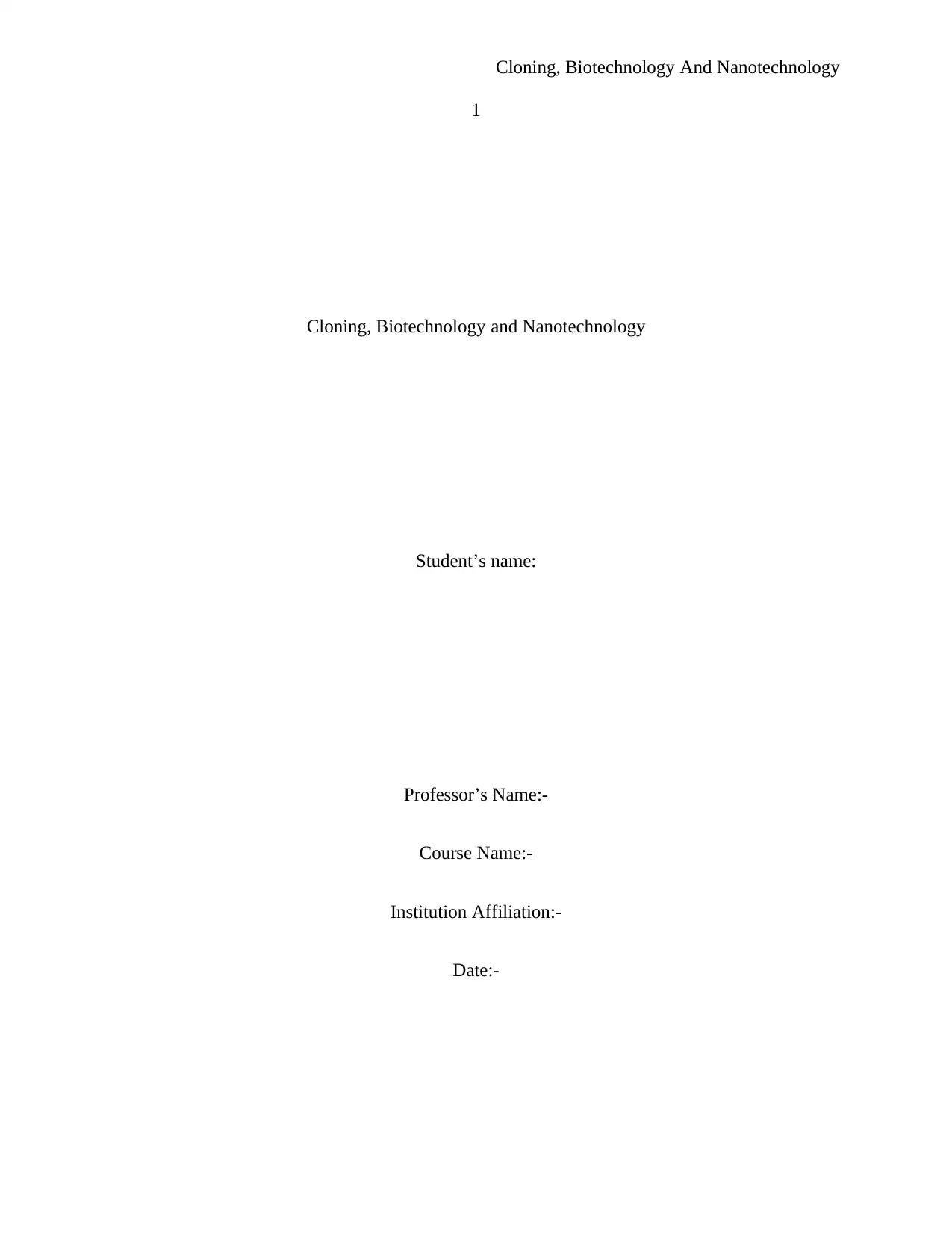
Cloning, Biotechnology And Nanotechnology
1
Cloning, Biotechnology and Nanotechnology
Student’s name:
Professor’s Name:-
Course Name:-
Institution Affiliation:-
Date:-
1
Cloning, Biotechnology and Nanotechnology
Student’s name:
Professor’s Name:-
Course Name:-
Institution Affiliation:-
Date:-
Paraphrase This Document
Need a fresh take? Get an instant paraphrase of this document with our AI Paraphraser
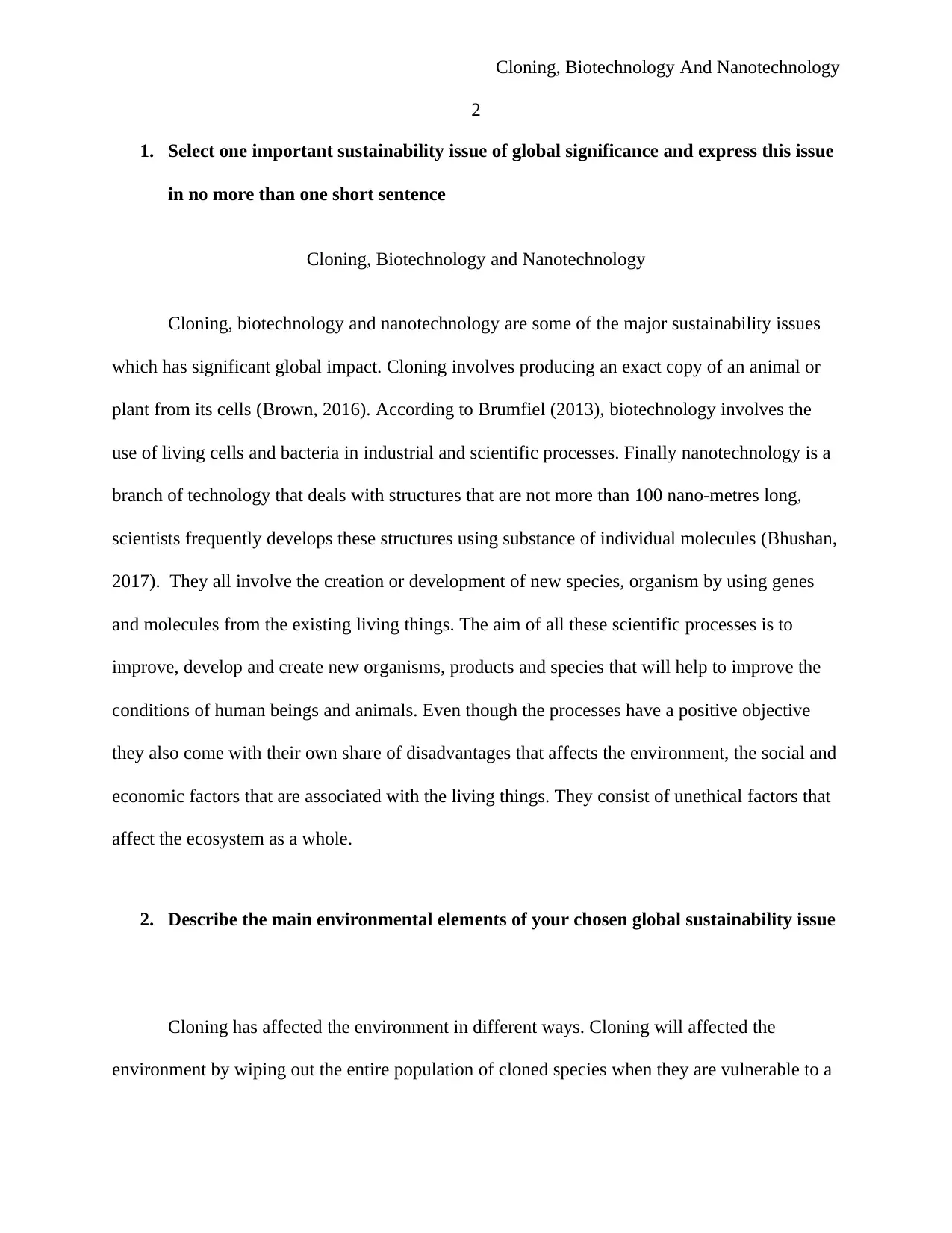
Cloning, Biotechnology And Nanotechnology
2
1. Select one important sustainability issue of global significance and express this issue
in no more than one short sentence
Cloning, Biotechnology and Nanotechnology
Cloning, biotechnology and nanotechnology are some of the major sustainability issues
which has significant global impact. Cloning involves producing an exact copy of an animal or
plant from its cells (Brown, 2016). According to Brumfiel (2013), biotechnology involves the
use of living cells and bacteria in industrial and scientific processes. Finally nanotechnology is a
branch of technology that deals with structures that are not more than 100 nano-metres long,
scientists frequently develops these structures using substance of individual molecules (Bhushan,
2017). They all involve the creation or development of new species, organism by using genes
and molecules from the existing living things. The aim of all these scientific processes is to
improve, develop and create new organisms, products and species that will help to improve the
conditions of human beings and animals. Even though the processes have a positive objective
they also come with their own share of disadvantages that affects the environment, the social and
economic factors that are associated with the living things. They consist of unethical factors that
affect the ecosystem as a whole.
2. Describe the main environmental elements of your chosen global sustainability issue
Cloning has affected the environment in different ways. Cloning will affected the
environment by wiping out the entire population of cloned species when they are vulnerable to a
2
1. Select one important sustainability issue of global significance and express this issue
in no more than one short sentence
Cloning, Biotechnology and Nanotechnology
Cloning, biotechnology and nanotechnology are some of the major sustainability issues
which has significant global impact. Cloning involves producing an exact copy of an animal or
plant from its cells (Brown, 2016). According to Brumfiel (2013), biotechnology involves the
use of living cells and bacteria in industrial and scientific processes. Finally nanotechnology is a
branch of technology that deals with structures that are not more than 100 nano-metres long,
scientists frequently develops these structures using substance of individual molecules (Bhushan,
2017). They all involve the creation or development of new species, organism by using genes
and molecules from the existing living things. The aim of all these scientific processes is to
improve, develop and create new organisms, products and species that will help to improve the
conditions of human beings and animals. Even though the processes have a positive objective
they also come with their own share of disadvantages that affects the environment, the social and
economic factors that are associated with the living things. They consist of unethical factors that
affect the ecosystem as a whole.
2. Describe the main environmental elements of your chosen global sustainability issue
Cloning has affected the environment in different ways. Cloning will affected the
environment by wiping out the entire population of cloned species when they are vulnerable to a
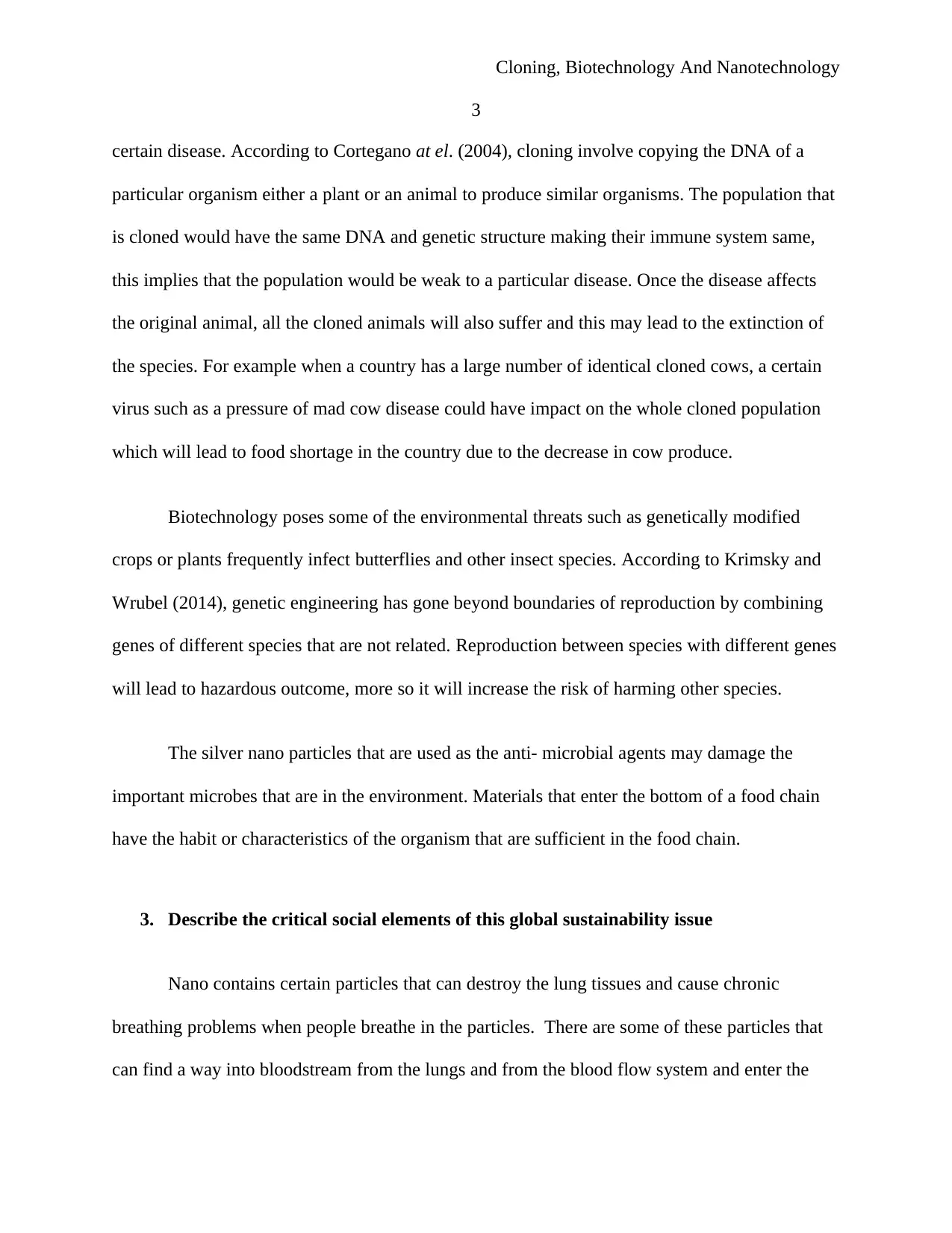
Cloning, Biotechnology And Nanotechnology
3
certain disease. According to Cortegano at el. (2004), cloning involve copying the DNA of a
particular organism either a plant or an animal to produce similar organisms. The population that
is cloned would have the same DNA and genetic structure making their immune system same,
this implies that the population would be weak to a particular disease. Once the disease affects
the original animal, all the cloned animals will also suffer and this may lead to the extinction of
the species. For example when a country has a large number of identical cloned cows, a certain
virus such as a pressure of mad cow disease could have impact on the whole cloned population
which will lead to food shortage in the country due to the decrease in cow produce.
Biotechnology poses some of the environmental threats such as genetically modified
crops or plants frequently infect butterflies and other insect species. According to Krimsky and
Wrubel (2014), genetic engineering has gone beyond boundaries of reproduction by combining
genes of different species that are not related. Reproduction between species with different genes
will lead to hazardous outcome, more so it will increase the risk of harming other species.
The silver nano particles that are used as the anti- microbial agents may damage the
important microbes that are in the environment. Materials that enter the bottom of a food chain
have the habit or characteristics of the organism that are sufficient in the food chain.
3. Describe the critical social elements of this global sustainability issue
Nano contains certain particles that can destroy the lung tissues and cause chronic
breathing problems when people breathe in the particles. There are some of these particles that
can find a way into bloodstream from the lungs and from the blood flow system and enter the
3
certain disease. According to Cortegano at el. (2004), cloning involve copying the DNA of a
particular organism either a plant or an animal to produce similar organisms. The population that
is cloned would have the same DNA and genetic structure making their immune system same,
this implies that the population would be weak to a particular disease. Once the disease affects
the original animal, all the cloned animals will also suffer and this may lead to the extinction of
the species. For example when a country has a large number of identical cloned cows, a certain
virus such as a pressure of mad cow disease could have impact on the whole cloned population
which will lead to food shortage in the country due to the decrease in cow produce.
Biotechnology poses some of the environmental threats such as genetically modified
crops or plants frequently infect butterflies and other insect species. According to Krimsky and
Wrubel (2014), genetic engineering has gone beyond boundaries of reproduction by combining
genes of different species that are not related. Reproduction between species with different genes
will lead to hazardous outcome, more so it will increase the risk of harming other species.
The silver nano particles that are used as the anti- microbial agents may damage the
important microbes that are in the environment. Materials that enter the bottom of a food chain
have the habit or characteristics of the organism that are sufficient in the food chain.
3. Describe the critical social elements of this global sustainability issue
Nano contains certain particles that can destroy the lung tissues and cause chronic
breathing problems when people breathe in the particles. There are some of these particles that
can find a way into bloodstream from the lungs and from the blood flow system and enter the
⊘ This is a preview!⊘
Do you want full access?
Subscribe today to unlock all pages.

Trusted by 1+ million students worldwide
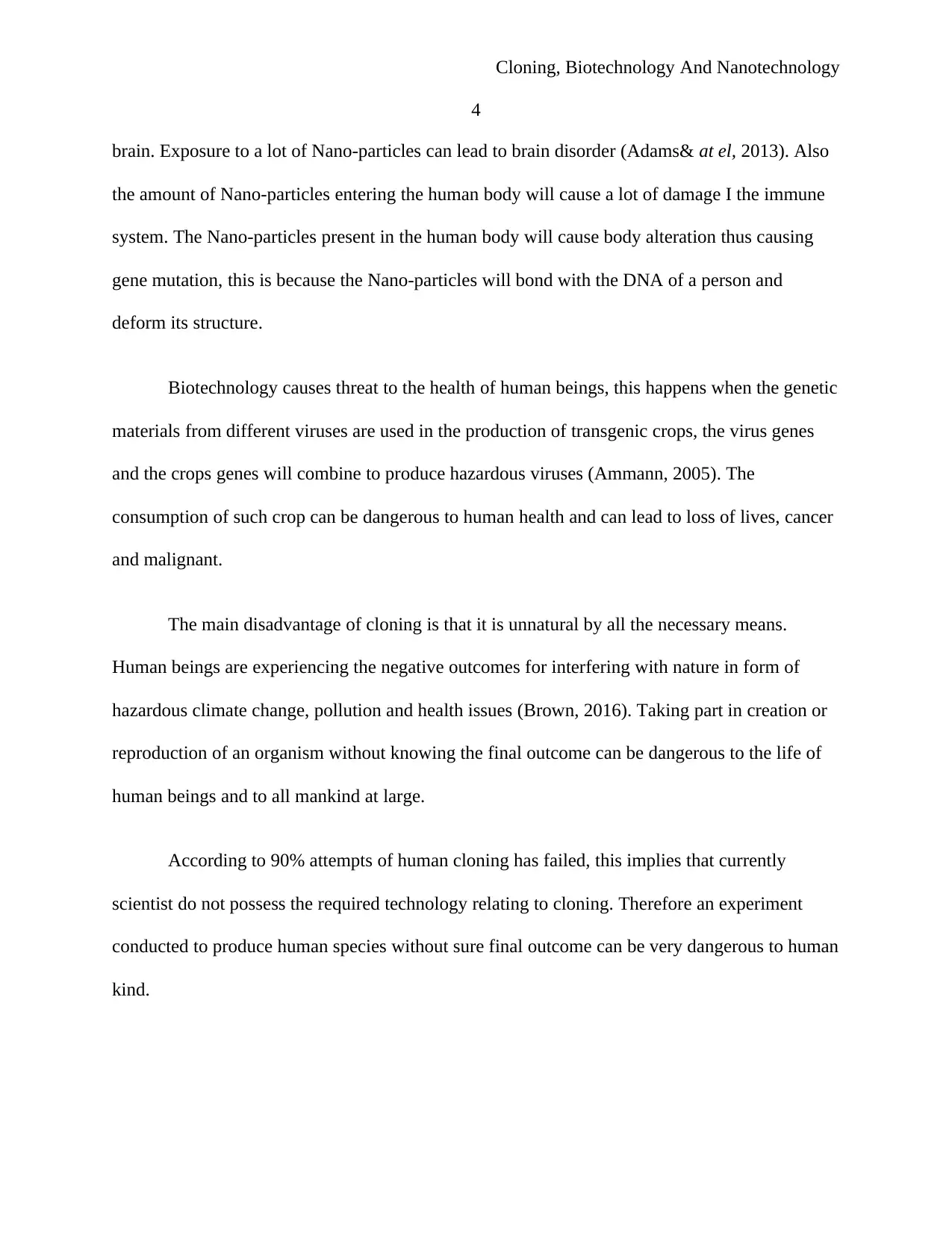
Cloning, Biotechnology And Nanotechnology
4
brain. Exposure to a lot of Nano-particles can lead to brain disorder (Adams& at el, 2013). Also
the amount of Nano-particles entering the human body will cause a lot of damage I the immune
system. The Nano-particles present in the human body will cause body alteration thus causing
gene mutation, this is because the Nano-particles will bond with the DNA of a person and
deform its structure.
Biotechnology causes threat to the health of human beings, this happens when the genetic
materials from different viruses are used in the production of transgenic crops, the virus genes
and the crops genes will combine to produce hazardous viruses (Ammann, 2005). The
consumption of such crop can be dangerous to human health and can lead to loss of lives, cancer
and malignant.
The main disadvantage of cloning is that it is unnatural by all the necessary means.
Human beings are experiencing the negative outcomes for interfering with nature in form of
hazardous climate change, pollution and health issues (Brown, 2016). Taking part in creation or
reproduction of an organism without knowing the final outcome can be dangerous to the life of
human beings and to all mankind at large.
According to 90% attempts of human cloning has failed, this implies that currently
scientist do not possess the required technology relating to cloning. Therefore an experiment
conducted to produce human species without sure final outcome can be very dangerous to human
kind.
4
brain. Exposure to a lot of Nano-particles can lead to brain disorder (Adams& at el, 2013). Also
the amount of Nano-particles entering the human body will cause a lot of damage I the immune
system. The Nano-particles present in the human body will cause body alteration thus causing
gene mutation, this is because the Nano-particles will bond with the DNA of a person and
deform its structure.
Biotechnology causes threat to the health of human beings, this happens when the genetic
materials from different viruses are used in the production of transgenic crops, the virus genes
and the crops genes will combine to produce hazardous viruses (Ammann, 2005). The
consumption of such crop can be dangerous to human health and can lead to loss of lives, cancer
and malignant.
The main disadvantage of cloning is that it is unnatural by all the necessary means.
Human beings are experiencing the negative outcomes for interfering with nature in form of
hazardous climate change, pollution and health issues (Brown, 2016). Taking part in creation or
reproduction of an organism without knowing the final outcome can be dangerous to the life of
human beings and to all mankind at large.
According to 90% attempts of human cloning has failed, this implies that currently
scientist do not possess the required technology relating to cloning. Therefore an experiment
conducted to produce human species without sure final outcome can be very dangerous to human
kind.
Paraphrase This Document
Need a fresh take? Get an instant paraphrase of this document with our AI Paraphraser
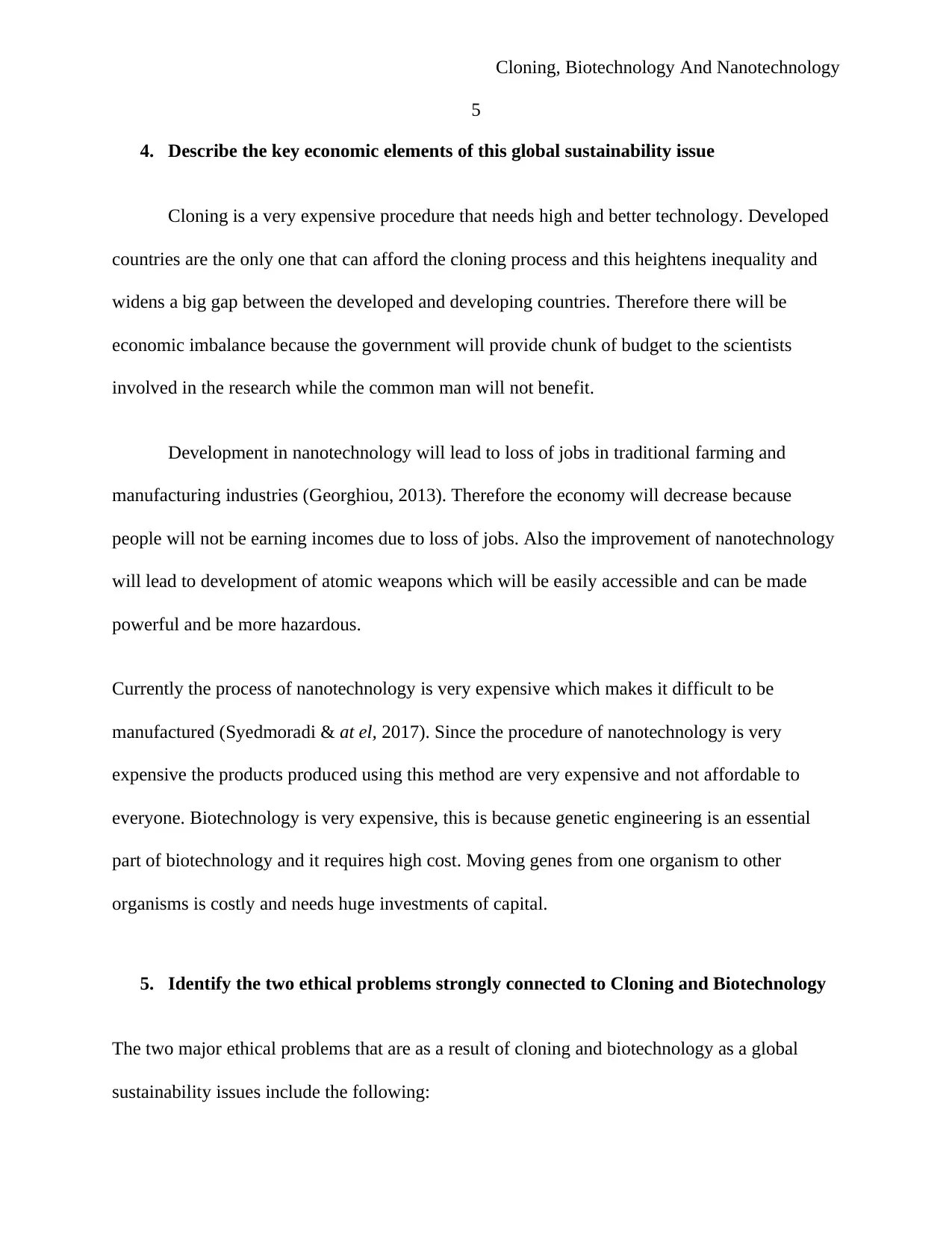
Cloning, Biotechnology And Nanotechnology
5
4. Describe the key economic elements of this global sustainability issue
Cloning is a very expensive procedure that needs high and better technology. Developed
countries are the only one that can afford the cloning process and this heightens inequality and
widens a big gap between the developed and developing countries. Therefore there will be
economic imbalance because the government will provide chunk of budget to the scientists
involved in the research while the common man will not benefit.
Development in nanotechnology will lead to loss of jobs in traditional farming and
manufacturing industries (Georghiou, 2013). Therefore the economy will decrease because
people will not be earning incomes due to loss of jobs. Also the improvement of nanotechnology
will lead to development of atomic weapons which will be easily accessible and can be made
powerful and be more hazardous.
Currently the process of nanotechnology is very expensive which makes it difficult to be
manufactured (Syedmoradi & at el, 2017). Since the procedure of nanotechnology is very
expensive the products produced using this method are very expensive and not affordable to
everyone. Biotechnology is very expensive, this is because genetic engineering is an essential
part of biotechnology and it requires high cost. Moving genes from one organism to other
organisms is costly and needs huge investments of capital.
5. Identify the two ethical problems strongly connected to Cloning and Biotechnology
The two major ethical problems that are as a result of cloning and biotechnology as a global
sustainability issues include the following:
5
4. Describe the key economic elements of this global sustainability issue
Cloning is a very expensive procedure that needs high and better technology. Developed
countries are the only one that can afford the cloning process and this heightens inequality and
widens a big gap between the developed and developing countries. Therefore there will be
economic imbalance because the government will provide chunk of budget to the scientists
involved in the research while the common man will not benefit.
Development in nanotechnology will lead to loss of jobs in traditional farming and
manufacturing industries (Georghiou, 2013). Therefore the economy will decrease because
people will not be earning incomes due to loss of jobs. Also the improvement of nanotechnology
will lead to development of atomic weapons which will be easily accessible and can be made
powerful and be more hazardous.
Currently the process of nanotechnology is very expensive which makes it difficult to be
manufactured (Syedmoradi & at el, 2017). Since the procedure of nanotechnology is very
expensive the products produced using this method are very expensive and not affordable to
everyone. Biotechnology is very expensive, this is because genetic engineering is an essential
part of biotechnology and it requires high cost. Moving genes from one organism to other
organisms is costly and needs huge investments of capital.
5. Identify the two ethical problems strongly connected to Cloning and Biotechnology
The two major ethical problems that are as a result of cloning and biotechnology as a global
sustainability issues include the following:
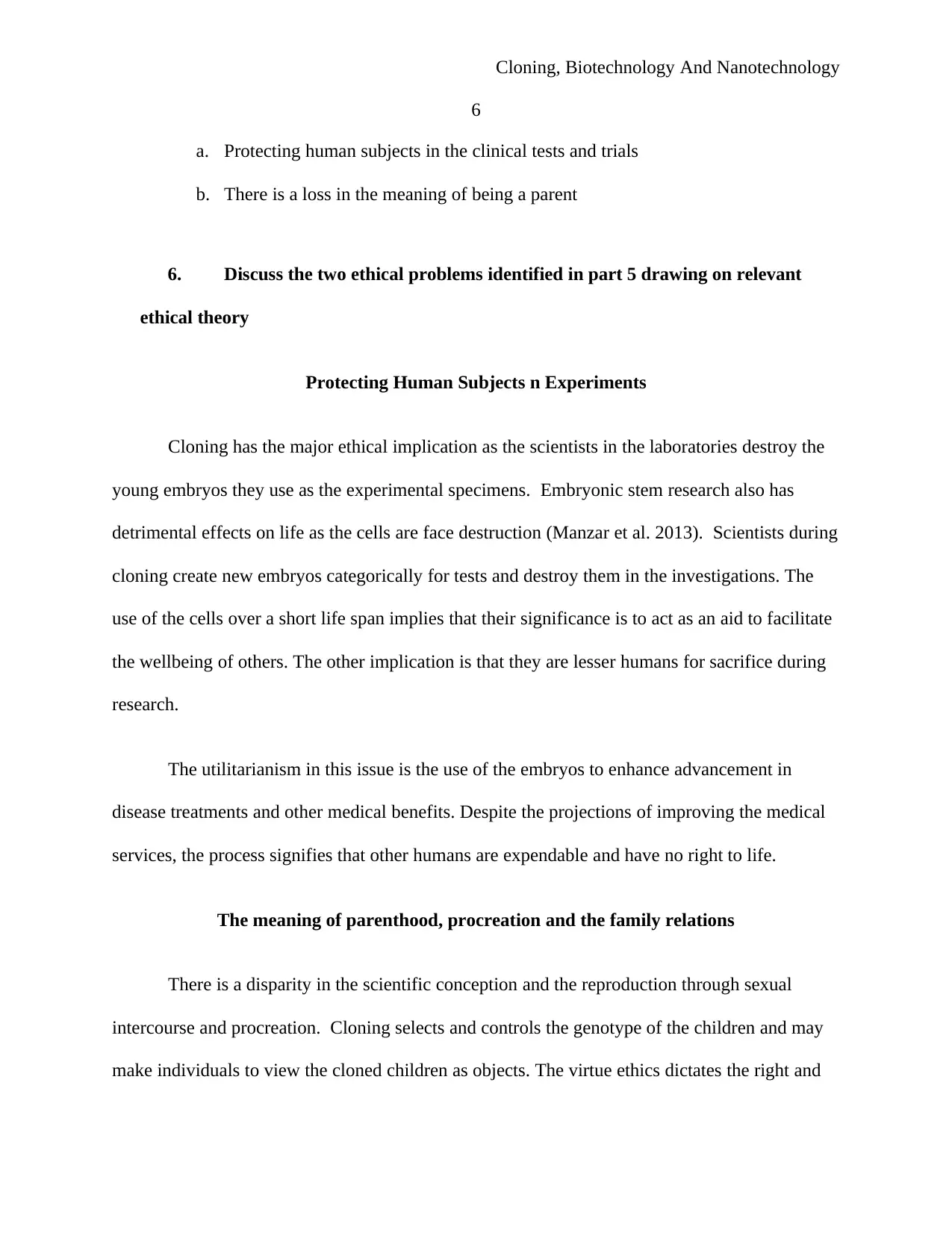
Cloning, Biotechnology And Nanotechnology
6
a. Protecting human subjects in the clinical tests and trials
b. There is a loss in the meaning of being a parent
6. Discuss the two ethical problems identified in part 5 drawing on relevant
ethical theory
Protecting Human Subjects n Experiments
Cloning has the major ethical implication as the scientists in the laboratories destroy the
young embryos they use as the experimental specimens. Embryonic stem research also has
detrimental effects on life as the cells are face destruction (Manzar et al. 2013). Scientists during
cloning create new embryos categorically for tests and destroy them in the investigations. The
use of the cells over a short life span implies that their significance is to act as an aid to facilitate
the wellbeing of others. The other implication is that they are lesser humans for sacrifice during
research.
The utilitarianism in this issue is the use of the embryos to enhance advancement in
disease treatments and other medical benefits. Despite the projections of improving the medical
services, the process signifies that other humans are expendable and have no right to life.
The meaning of parenthood, procreation and the family relations
There is a disparity in the scientific conception and the reproduction through sexual
intercourse and procreation. Cloning selects and controls the genotype of the children and may
make individuals to view the cloned children as objects. The virtue ethics dictates the right and
6
a. Protecting human subjects in the clinical tests and trials
b. There is a loss in the meaning of being a parent
6. Discuss the two ethical problems identified in part 5 drawing on relevant
ethical theory
Protecting Human Subjects n Experiments
Cloning has the major ethical implication as the scientists in the laboratories destroy the
young embryos they use as the experimental specimens. Embryonic stem research also has
detrimental effects on life as the cells are face destruction (Manzar et al. 2013). Scientists during
cloning create new embryos categorically for tests and destroy them in the investigations. The
use of the cells over a short life span implies that their significance is to act as an aid to facilitate
the wellbeing of others. The other implication is that they are lesser humans for sacrifice during
research.
The utilitarianism in this issue is the use of the embryos to enhance advancement in
disease treatments and other medical benefits. Despite the projections of improving the medical
services, the process signifies that other humans are expendable and have no right to life.
The meaning of parenthood, procreation and the family relations
There is a disparity in the scientific conception and the reproduction through sexual
intercourse and procreation. Cloning selects and controls the genotype of the children and may
make individuals to view the cloned children as objects. The virtue ethics dictates the right and
⊘ This is a preview!⊘
Do you want full access?
Subscribe today to unlock all pages.

Trusted by 1+ million students worldwide
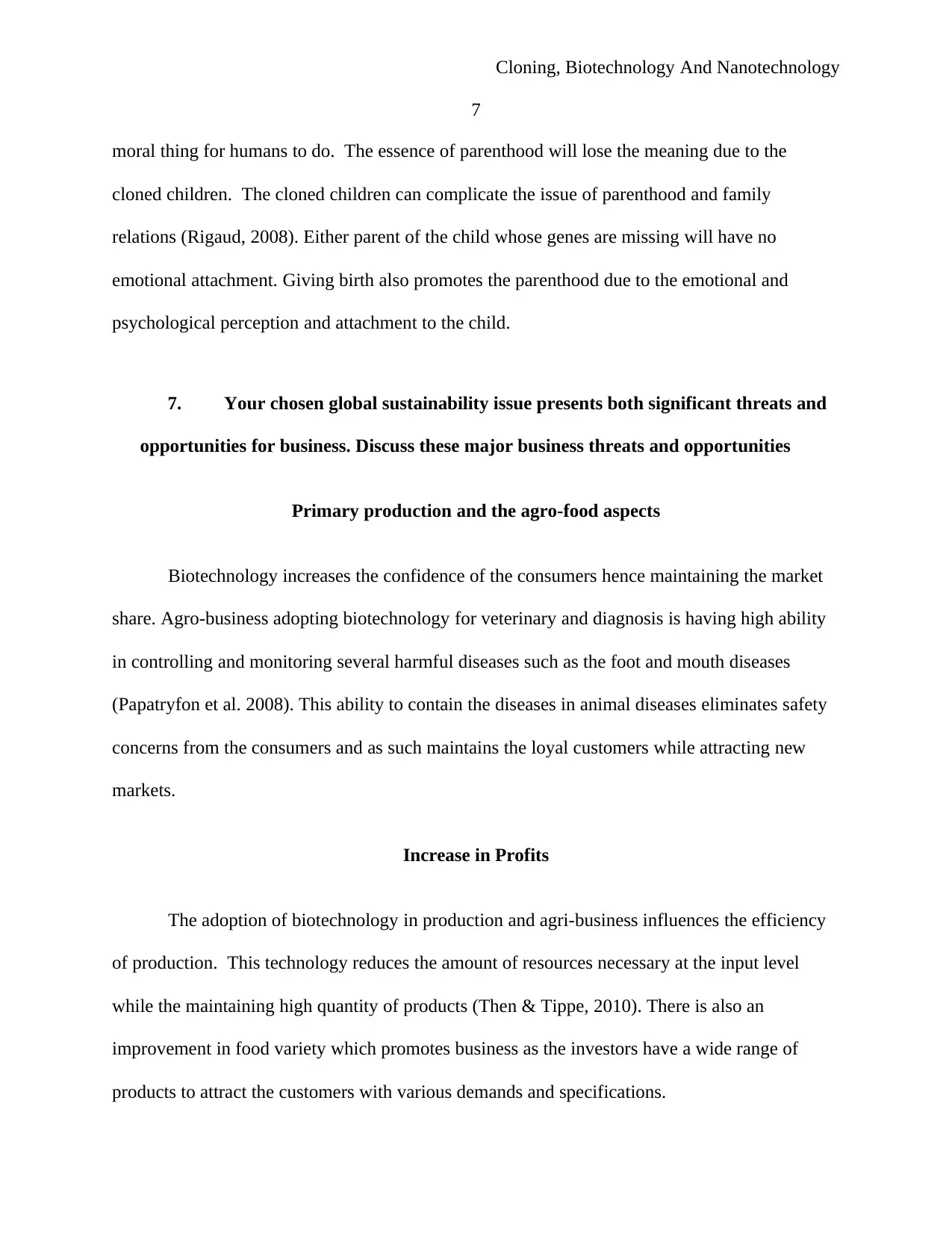
Cloning, Biotechnology And Nanotechnology
7
moral thing for humans to do. The essence of parenthood will lose the meaning due to the
cloned children. The cloned children can complicate the issue of parenthood and family
relations (Rigaud, 2008). Either parent of the child whose genes are missing will have no
emotional attachment. Giving birth also promotes the parenthood due to the emotional and
psychological perception and attachment to the child.
7. Your chosen global sustainability issue presents both significant threats and
opportunities for business. Discuss these major business threats and opportunities
Primary production and the agro-food aspects
Biotechnology increases the confidence of the consumers hence maintaining the market
share. Agro-business adopting biotechnology for veterinary and diagnosis is having high ability
in controlling and monitoring several harmful diseases such as the foot and mouth diseases
(Papatryfon et al. 2008). This ability to contain the diseases in animal diseases eliminates safety
concerns from the consumers and as such maintains the loyal customers while attracting new
markets.
Increase in Profits
The adoption of biotechnology in production and agri-business influences the efficiency
of production. This technology reduces the amount of resources necessary at the input level
while the maintaining high quantity of products (Then & Tippe, 2010). There is also an
improvement in food variety which promotes business as the investors have a wide range of
products to attract the customers with various demands and specifications.
7
moral thing for humans to do. The essence of parenthood will lose the meaning due to the
cloned children. The cloned children can complicate the issue of parenthood and family
relations (Rigaud, 2008). Either parent of the child whose genes are missing will have no
emotional attachment. Giving birth also promotes the parenthood due to the emotional and
psychological perception and attachment to the child.
7. Your chosen global sustainability issue presents both significant threats and
opportunities for business. Discuss these major business threats and opportunities
Primary production and the agro-food aspects
Biotechnology increases the confidence of the consumers hence maintaining the market
share. Agro-business adopting biotechnology for veterinary and diagnosis is having high ability
in controlling and monitoring several harmful diseases such as the foot and mouth diseases
(Papatryfon et al. 2008). This ability to contain the diseases in animal diseases eliminates safety
concerns from the consumers and as such maintains the loyal customers while attracting new
markets.
Increase in Profits
The adoption of biotechnology in production and agri-business influences the efficiency
of production. This technology reduces the amount of resources necessary at the input level
while the maintaining high quantity of products (Then & Tippe, 2010). There is also an
improvement in food variety which promotes business as the investors have a wide range of
products to attract the customers with various demands and specifications.
Paraphrase This Document
Need a fresh take? Get an instant paraphrase of this document with our AI Paraphraser
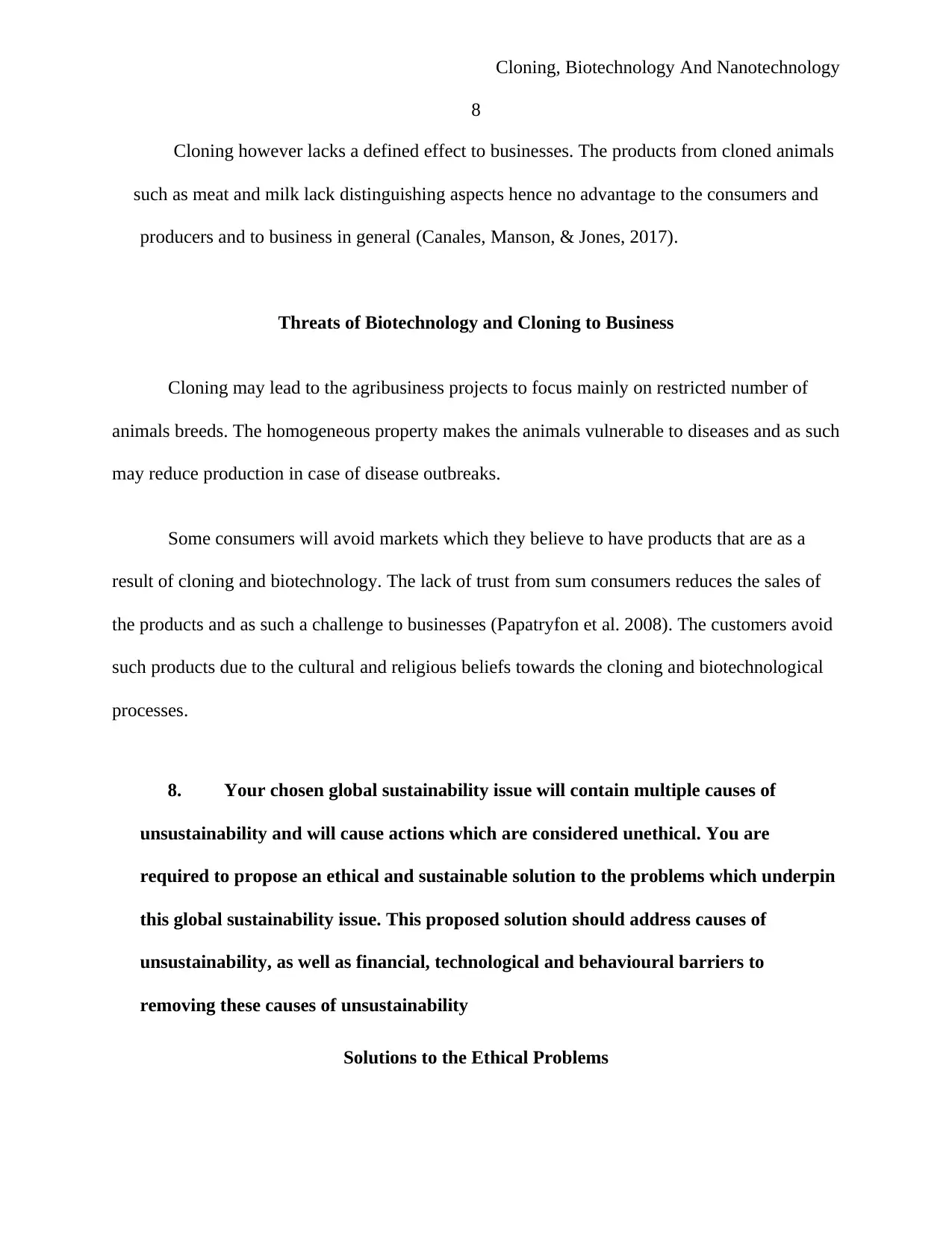
Cloning, Biotechnology And Nanotechnology
8
Cloning however lacks a defined effect to businesses. The products from cloned animals
such as meat and milk lack distinguishing aspects hence no advantage to the consumers and
producers and to business in general (Canales, Manson, & Jones, 2017).
Threats of Biotechnology and Cloning to Business
Cloning may lead to the agribusiness projects to focus mainly on restricted number of
animals breeds. The homogeneous property makes the animals vulnerable to diseases and as such
may reduce production in case of disease outbreaks.
Some consumers will avoid markets which they believe to have products that are as a
result of cloning and biotechnology. The lack of trust from sum consumers reduces the sales of
the products and as such a challenge to businesses (Papatryfon et al. 2008). The customers avoid
such products due to the cultural and religious beliefs towards the cloning and biotechnological
processes.
8. Your chosen global sustainability issue will contain multiple causes of
unsustainability and will cause actions which are considered unethical. You are
required to propose an ethical and sustainable solution to the problems which underpin
this global sustainability issue. This proposed solution should address causes of
unsustainability, as well as financial, technological and behavioural barriers to
removing these causes of unsustainability
Solutions to the Ethical Problems
8
Cloning however lacks a defined effect to businesses. The products from cloned animals
such as meat and milk lack distinguishing aspects hence no advantage to the consumers and
producers and to business in general (Canales, Manson, & Jones, 2017).
Threats of Biotechnology and Cloning to Business
Cloning may lead to the agribusiness projects to focus mainly on restricted number of
animals breeds. The homogeneous property makes the animals vulnerable to diseases and as such
may reduce production in case of disease outbreaks.
Some consumers will avoid markets which they believe to have products that are as a
result of cloning and biotechnology. The lack of trust from sum consumers reduces the sales of
the products and as such a challenge to businesses (Papatryfon et al. 2008). The customers avoid
such products due to the cultural and religious beliefs towards the cloning and biotechnological
processes.
8. Your chosen global sustainability issue will contain multiple causes of
unsustainability and will cause actions which are considered unethical. You are
required to propose an ethical and sustainable solution to the problems which underpin
this global sustainability issue. This proposed solution should address causes of
unsustainability, as well as financial, technological and behavioural barriers to
removing these causes of unsustainability
Solutions to the Ethical Problems
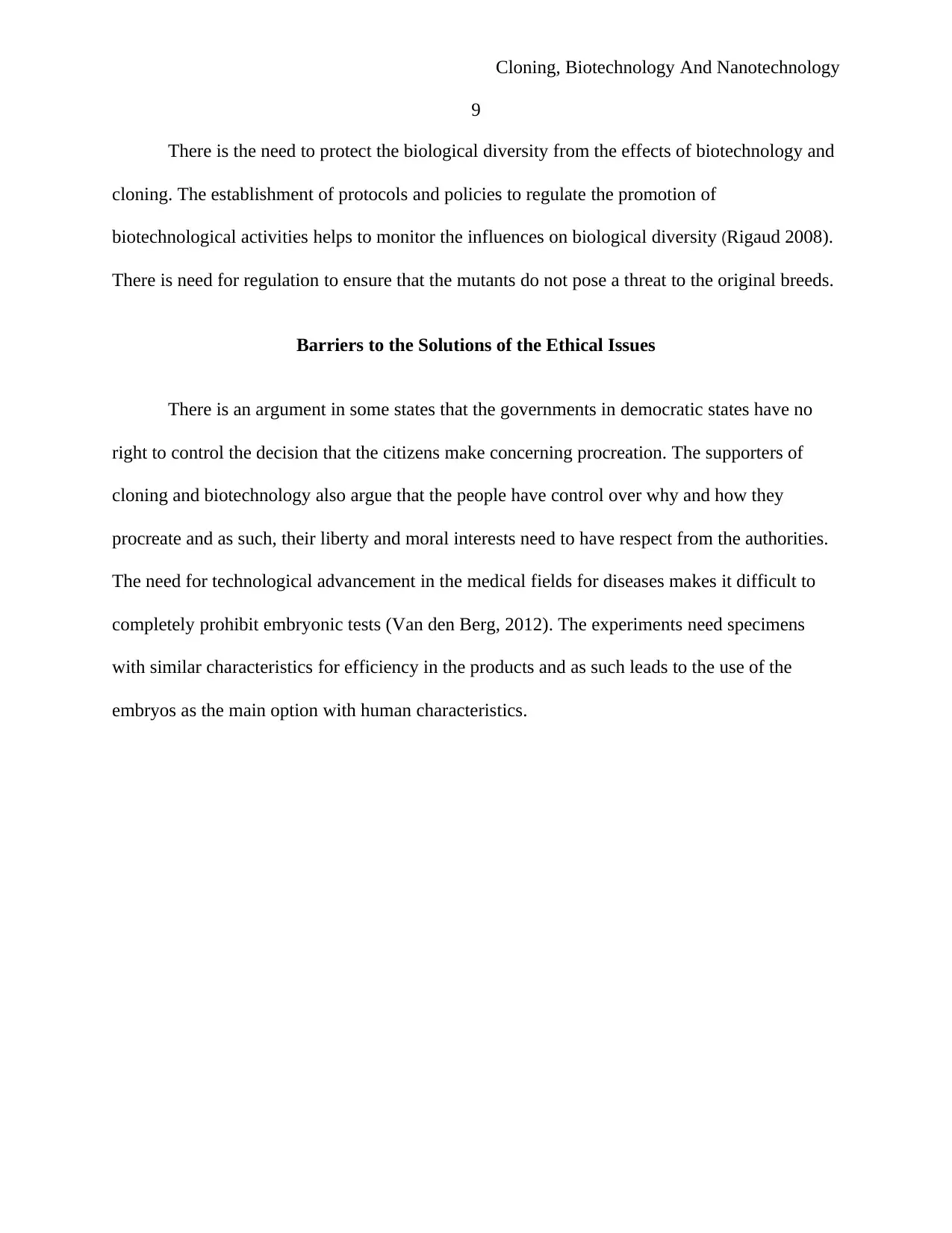
Cloning, Biotechnology And Nanotechnology
9
There is the need to protect the biological diversity from the effects of biotechnology and
cloning. The establishment of protocols and policies to regulate the promotion of
biotechnological activities helps to monitor the influences on biological diversity (Rigaud 2008).
There is need for regulation to ensure that the mutants do not pose a threat to the original breeds.
Barriers to the Solutions of the Ethical Issues
There is an argument in some states that the governments in democratic states have no
right to control the decision that the citizens make concerning procreation. The supporters of
cloning and biotechnology also argue that the people have control over why and how they
procreate and as such, their liberty and moral interests need to have respect from the authorities.
The need for technological advancement in the medical fields for diseases makes it difficult to
completely prohibit embryonic tests (Van den Berg, 2012). The experiments need specimens
with similar characteristics for efficiency in the products and as such leads to the use of the
embryos as the main option with human characteristics.
9
There is the need to protect the biological diversity from the effects of biotechnology and
cloning. The establishment of protocols and policies to regulate the promotion of
biotechnological activities helps to monitor the influences on biological diversity (Rigaud 2008).
There is need for regulation to ensure that the mutants do not pose a threat to the original breeds.
Barriers to the Solutions of the Ethical Issues
There is an argument in some states that the governments in democratic states have no
right to control the decision that the citizens make concerning procreation. The supporters of
cloning and biotechnology also argue that the people have control over why and how they
procreate and as such, their liberty and moral interests need to have respect from the authorities.
The need for technological advancement in the medical fields for diseases makes it difficult to
completely prohibit embryonic tests (Van den Berg, 2012). The experiments need specimens
with similar characteristics for efficiency in the products and as such leads to the use of the
embryos as the main option with human characteristics.
⊘ This is a preview!⊘
Do you want full access?
Subscribe today to unlock all pages.

Trusted by 1+ million students worldwide
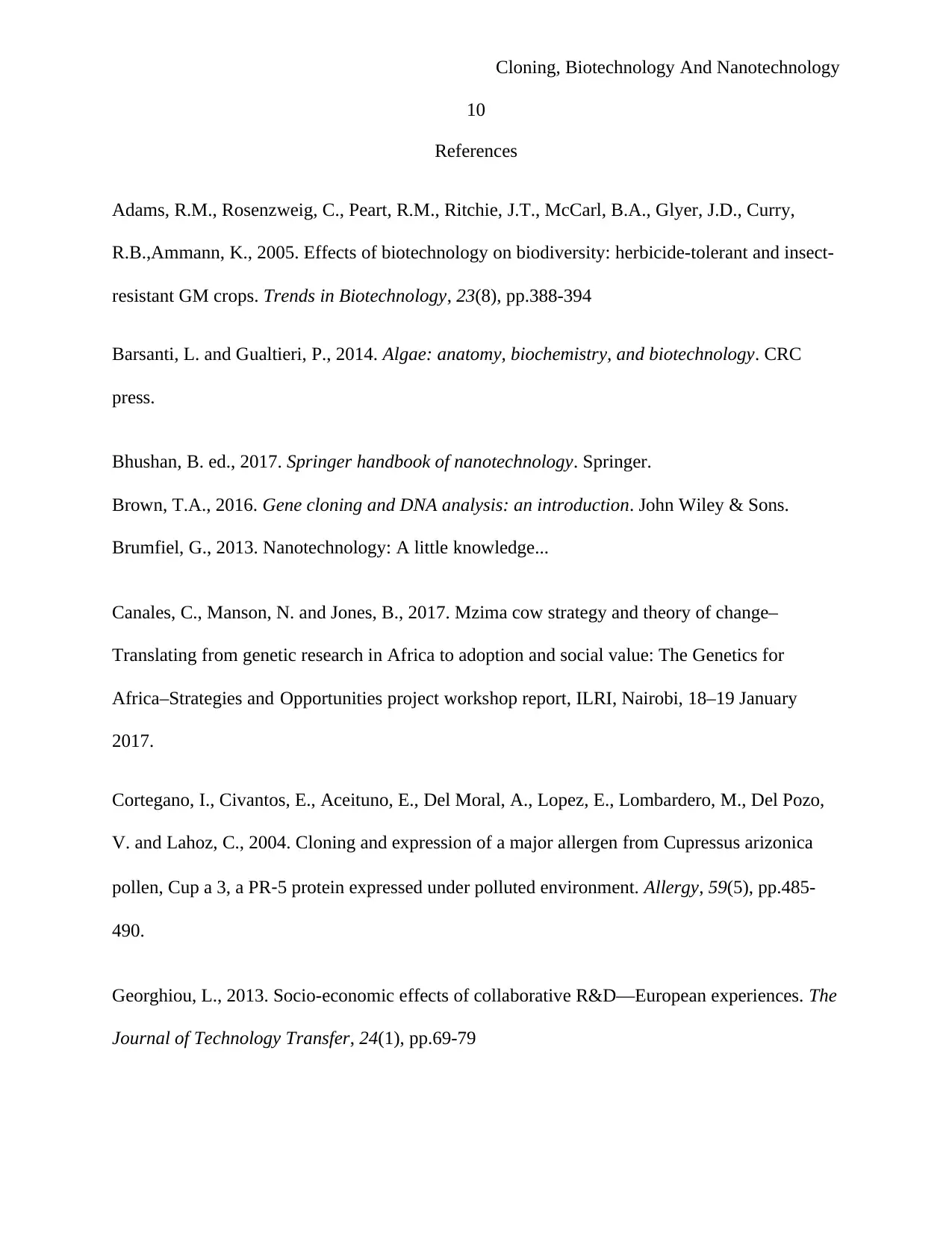
Cloning, Biotechnology And Nanotechnology
10
References
Adams, R.M., Rosenzweig, C., Peart, R.M., Ritchie, J.T., McCarl, B.A., Glyer, J.D., Curry,
R.B.,Ammann, K., 2005. Effects of biotechnology on biodiversity: herbicide-tolerant and insect-
resistant GM crops. Trends in Biotechnology, 23(8), pp.388-394
Barsanti, L. and Gualtieri, P., 2014. Algae: anatomy, biochemistry, and biotechnology. CRC
press.
Bhushan, B. ed., 2017. Springer handbook of nanotechnology. Springer.
Brown, T.A., 2016. Gene cloning and DNA analysis: an introduction. John Wiley & Sons.
Brumfiel, G., 2013. Nanotechnology: A little knowledge...
Canales, C., Manson, N. and Jones, B., 2017. Mzima cow strategy and theory of change–
Translating from genetic research in Africa to adoption and social value: The Genetics for
Africa–Strategies and Opportunities project workshop report, ILRI, Nairobi, 18–19 January
2017.
Cortegano, I., Civantos, E., Aceituno, E., Del Moral, A., Lopez, E., Lombardero, M., Del Pozo,
V. and Lahoz, C., 2004. Cloning and expression of a major allergen from Cupressus arizonica
pollen, Cup a 3, a PR‐5 protein expressed under polluted environment. Allergy, 59(5), pp.485-
490.
Georghiou, L., 2013. Socio-economic effects of collaborative R&D—European experiences. The
Journal of Technology Transfer, 24(1), pp.69-79
10
References
Adams, R.M., Rosenzweig, C., Peart, R.M., Ritchie, J.T., McCarl, B.A., Glyer, J.D., Curry,
R.B.,Ammann, K., 2005. Effects of biotechnology on biodiversity: herbicide-tolerant and insect-
resistant GM crops. Trends in Biotechnology, 23(8), pp.388-394
Barsanti, L. and Gualtieri, P., 2014. Algae: anatomy, biochemistry, and biotechnology. CRC
press.
Bhushan, B. ed., 2017. Springer handbook of nanotechnology. Springer.
Brown, T.A., 2016. Gene cloning and DNA analysis: an introduction. John Wiley & Sons.
Brumfiel, G., 2013. Nanotechnology: A little knowledge...
Canales, C., Manson, N. and Jones, B., 2017. Mzima cow strategy and theory of change–
Translating from genetic research in Africa to adoption and social value: The Genetics for
Africa–Strategies and Opportunities project workshop report, ILRI, Nairobi, 18–19 January
2017.
Cortegano, I., Civantos, E., Aceituno, E., Del Moral, A., Lopez, E., Lombardero, M., Del Pozo,
V. and Lahoz, C., 2004. Cloning and expression of a major allergen from Cupressus arizonica
pollen, Cup a 3, a PR‐5 protein expressed under polluted environment. Allergy, 59(5), pp.485-
490.
Georghiou, L., 2013. Socio-economic effects of collaborative R&D—European experiences. The
Journal of Technology Transfer, 24(1), pp.69-79
Paraphrase This Document
Need a fresh take? Get an instant paraphrase of this document with our AI Paraphraser
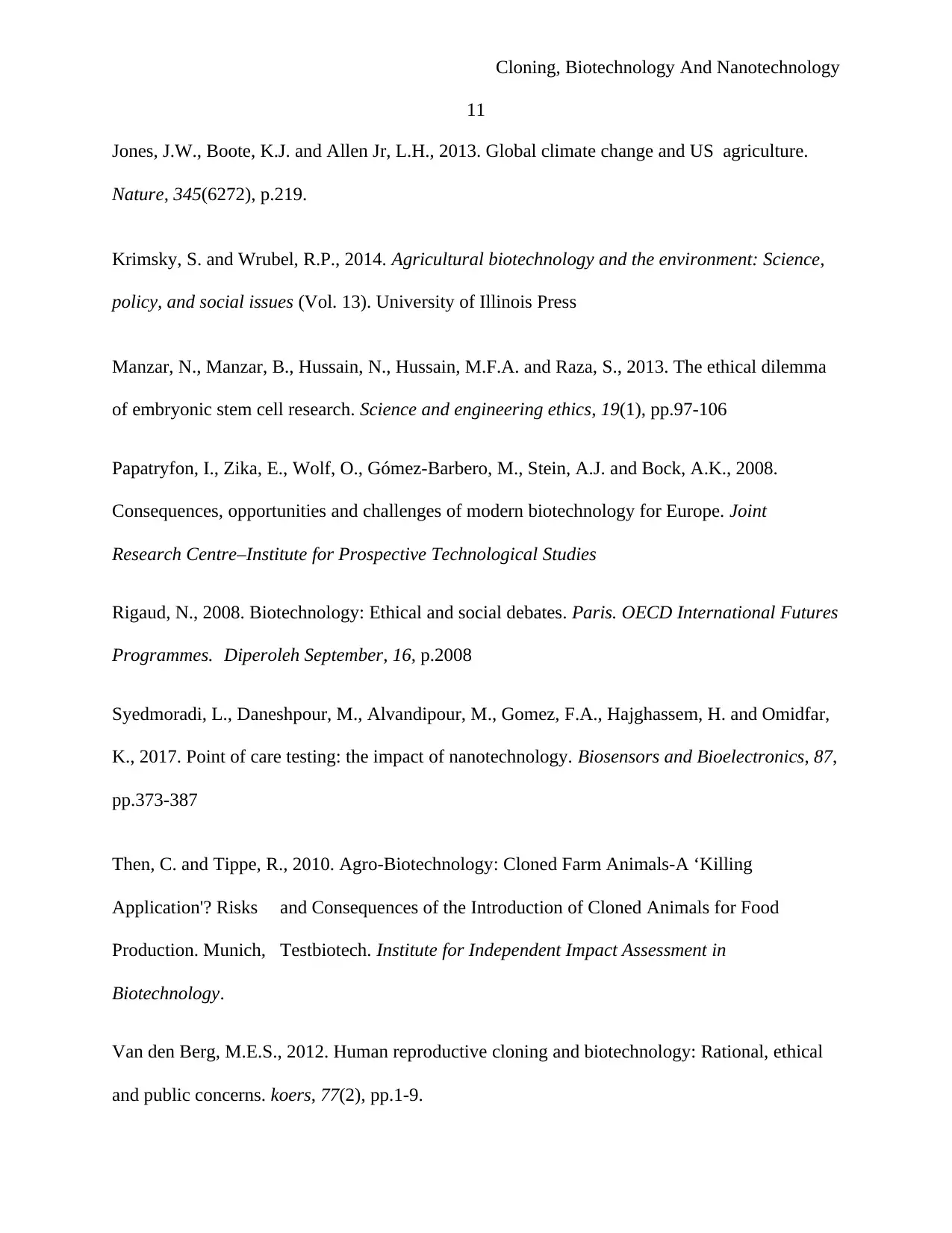
Cloning, Biotechnology And Nanotechnology
11
Jones, J.W., Boote, K.J. and Allen Jr, L.H., 2013. Global climate change and US agriculture.
Nature, 345(6272), p.219.
Krimsky, S. and Wrubel, R.P., 2014. Agricultural biotechnology and the environment: Science,
policy, and social issues (Vol. 13). University of Illinois Press
Manzar, N., Manzar, B., Hussain, N., Hussain, M.F.A. and Raza, S., 2013. The ethical dilemma
of embryonic stem cell research. Science and engineering ethics, 19(1), pp.97-106
Papatryfon, I., Zika, E., Wolf, O., Gómez-Barbero, M., Stein, A.J. and Bock, A.K., 2008.
Consequences, opportunities and challenges of modern biotechnology for Europe. Joint
Research Centre–Institute for Prospective Technological Studies
Rigaud, N., 2008. Biotechnology: Ethical and social debates. Paris. OECD International Futures
Programmes. Diperoleh September, 16, p.2008
Syedmoradi, L., Daneshpour, M., Alvandipour, M., Gomez, F.A., Hajghassem, H. and Omidfar,
K., 2017. Point of care testing: the impact of nanotechnology. Biosensors and Bioelectronics, 87,
pp.373-387
Then, C. and Tippe, R., 2010. Agro-Biotechnology: Cloned Farm Animals-A ‘Killing
Application'? Risks and Consequences of the Introduction of Cloned Animals for Food
Production. Munich, Testbiotech. Institute for Independent Impact Assessment in
Biotechnology.
Van den Berg, M.E.S., 2012. Human reproductive cloning and biotechnology: Rational, ethical
and public concerns. koers, 77(2), pp.1-9.
11
Jones, J.W., Boote, K.J. and Allen Jr, L.H., 2013. Global climate change and US agriculture.
Nature, 345(6272), p.219.
Krimsky, S. and Wrubel, R.P., 2014. Agricultural biotechnology and the environment: Science,
policy, and social issues (Vol. 13). University of Illinois Press
Manzar, N., Manzar, B., Hussain, N., Hussain, M.F.A. and Raza, S., 2013. The ethical dilemma
of embryonic stem cell research. Science and engineering ethics, 19(1), pp.97-106
Papatryfon, I., Zika, E., Wolf, O., Gómez-Barbero, M., Stein, A.J. and Bock, A.K., 2008.
Consequences, opportunities and challenges of modern biotechnology for Europe. Joint
Research Centre–Institute for Prospective Technological Studies
Rigaud, N., 2008. Biotechnology: Ethical and social debates. Paris. OECD International Futures
Programmes. Diperoleh September, 16, p.2008
Syedmoradi, L., Daneshpour, M., Alvandipour, M., Gomez, F.A., Hajghassem, H. and Omidfar,
K., 2017. Point of care testing: the impact of nanotechnology. Biosensors and Bioelectronics, 87,
pp.373-387
Then, C. and Tippe, R., 2010. Agro-Biotechnology: Cloned Farm Animals-A ‘Killing
Application'? Risks and Consequences of the Introduction of Cloned Animals for Food
Production. Munich, Testbiotech. Institute for Independent Impact Assessment in
Biotechnology.
Van den Berg, M.E.S., 2012. Human reproductive cloning and biotechnology: Rational, ethical
and public concerns. koers, 77(2), pp.1-9.
1 out of 11
Related Documents
Your All-in-One AI-Powered Toolkit for Academic Success.
+13062052269
info@desklib.com
Available 24*7 on WhatsApp / Email
![[object Object]](/_next/static/media/star-bottom.7253800d.svg)
Unlock your academic potential
Copyright © 2020–2025 A2Z Services. All Rights Reserved. Developed and managed by ZUCOL.





